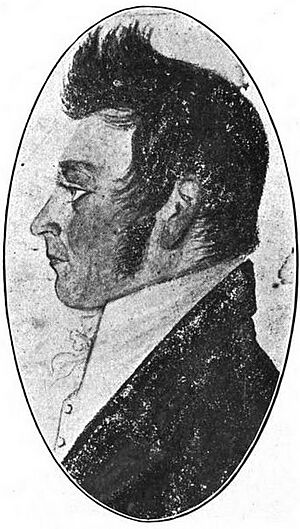Ner Middleswarth facts for kids
Ner Middleswarth (born December 12, 1783 – died June 2, 1865) was an American politician. He was a member of the Whig Party. He served in the U.S. House of Representatives for Pennsylvania's 10th congressional district from 1853 to 1855.
Middleswarth also served in the Pennsylvania State House of Representatives. He was a member from 1815 to 1841. During this time, he was chosen as the Speaker of the House twice. He also served in the Pennsylvania Senate for the 15th district from 1853 to 1854.
Early Life and Family
Ner Middleswarth was born on December 12, 1783, in New Jersey. His family had Dutch roots. His parents were John and Martha (Reed) Middleswarth. His father, John, was a Quartermaster Sergeant. He served in the New Jersey militia during the American Revolution.
The Middleswarth family came from the Netherlands. They first settled in New Amsterdam (now New York City). Then they moved to Flatbush and later to Somerset, New Jersey.
In 1792, when Ner was about nine years old, his family moved. They moved to Northumberland County, Pennsylvania. He grew up on a farm there. He had one brother, Abraham, and four sisters: Mary, Martha, Rachel, and Rebecca.
Ner Middleswarth had very little formal schooling. He only went to school for about three months. However, he taught himself to read and write. He learned both English and Pennsylvania German. He could speak both languages very well. He grew up to be a strong man. He was known for being loyal to his friends and neighbors. Ner married Christine Schwartzkop. Together, they had twelve children.
Serving His Country
In 1812, Ner Middleswarth showed his leadership. He gathered a group of volunteers. He became a captain in the War of 1812. His company was part of the Pennsylvania Riflemen. In 1814, he formed another company. This group joined General Thomas McCall Cadwalader's Division. They fought during the Niagara campaign.
After his military service, Middleswarth began his political career. In 1815, he was elected to the Pennsylvania House of Representatives. He was re-elected many times. He served in the Legislature from 1815 to 1842.
His fellow representatives chose him as Speaker of the House twice. He held this important role in 1828 and again in 1836.
Later, he was elected to the Pennsylvania State Senate. He served one term there. From 1853 to 1855, he was a member of the United States House of Representatives. He represented Pennsylvania's 10th congressional district. He was first a member of the Whig Party. Later, he joined the Republican Party.
In 1858, he took on his last public role. He served as an Associate Judge in his county.
Later Life
Ner Middleswarth was also successful in business. However, he lost a lot of his money. This happened because of a failed iron business. It was called "Beaver Furnace" and was near Paxtonville, Pennsylvania.
Ner Middleswarth passed away on June 2, 1865. He was 81 years old. He is buried with his wife, Christina Schwartzkop. Their graves are at Beavertown Cemetery in Beavertown, Snyder County, Pennsylvania.
See also
- Speaker of the Pennsylvania House of Representatives
Sources
- The Political Graveyard
| Pennsylvania House of Representatives | ||
|---|---|---|
| Preceded by ' |
Member of the Pennsylvania House of Representatives 1815-1841 |
Succeeded by |
| Political offices | ||
| Preceded by Joseph Ritner |
Speaker of the Pennsylvania House of Representatives 1828-1829 |
Succeeded by Frederick Smith |
| Preceded by James Thompson |
Speaker of the Pennsylvania House of Representatives 1836 |
Succeeded by Lewis Dewart |
| Pennsylvania State Senate | ||
| Preceded by Robert Allison McMurtrie |
Member of the Pennsylvania Senate, 15th district 1853-1855 |
Succeeded by John Creswell, Jr. |
| United States House of Representatives | ||
| Preceded by Milo M. Dimmick |
Member of the U.S. House of Representatives from Pennsylvania's 10th congressional district 1853–1855 |
Succeeded by John Christian Kunkel |


